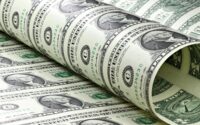Treasury Yield-Curve Inversion Reaches a Four-Decade Extreme
(Bloomberg) — A key segment of the US Treasury yield curve reached new extremes of inversion Thursday, touching a level not seen since the early 1980s when the Federal Reserve also was aggressively tightening policy.
Most Read from Bloomberg
The two-year note’s yield exceeded the 10-year note’s by as much as 58.6 basis points. The inversion briefly exceeded 58 basis points on Aug. 10, last seen about forty years ago when then-Fed Chair Paul Volcker’s rate hikes to break inflation tanked the economy. Curve inversions have a track record of preceding economic downturns by 12 to 18 months.
The policy-sensitive two-year has led this year’s relentless rise in Treasury yields, with the latest bout of selling coming after Fed Chair Jerome Powell indicated Wednesday that policy rates will likely rise more than previously anticipated and stay elevated as the central bank seeks to bring down inflation. Powell said the Fed has “a ways to go” to get interest rates to a sufficiently restrictive level.
The two-year versus 10-year curve has narrowed in the region of 1.5 percentage points this year as the Fed aggressively front-loaded rate hikes. Curve inversion signifies that investors expect policy tightening to cause a recession and also reduce inflation and in turn that boosts demand for longer-dated bonds. The expected peak in the policy rate topped 5% Thursday, a day after the Fed increased the range to 3.75%-4%.
“We think that the curve can keep inverting for now since the Fed is likely to keep raising rates and will tolerate some slowing in the economy,” a team led by Priya Misra, global head of rates strategy at TD Securities, wrote in a note. “This more aggressive than expected hiking path has an unfortunate consequence. The amount of real tightening that we expect now to happen will likely lead the economy to a recession in the second half of 2023.”
The prospect of a resilient job sector and sticky inflation into next year is behind the Fed looking at a higher terminal rate forecast when they meet in December. Before that meeting, two readings of US consumer prices will arrive, with the October data out next week. That follows the monthly jobs report due Friday and expected to show tight labor market conditions for last month.
“Any strength in the data from here will result in higher yields and more curve inversion,” said George Goncalves, head of US macro strategy at MUFG.
Another slice of the yield curve, the difference three-month rates and where they are expected to be in 18 months’ time, is also near inverting. Powell has said the Fed favors that spread as a predictor of conditions that could lead to rate cuts.
Rates for swaps that reference future Fed policy meetings climbed further Thursday, with the May and June 2023 contracts indicating an expected peak rate of nearly 5.15%, from levels below 5% Wednesday. That was accompanied by the two-year yield rising as much as 12 basis points to around 4.74%, the highest level since 2007.
Since August the two- to 10-year spread has been inverted by as little as 14 basis points, with flattening moves generally caused by the two-year yield rising more than the 10-year.
–With assistance from Liz Capo McCormick.
(Adds analyst’s comment in seventh paragraph. A previous version was corrected to fix day of week in first paragraph.)
©2022 Bloomberg L.P.
[ad_2]
Source link


